Intel Core i7-10700 vs Core i7-10700K Review: Is 65W Comet Lake an Option?
by Dr. Ian Cutress on January 21, 2021 10:30 AM EST- Posted in
- CPUs
- Intel
- Core i7
- Z490
- 10th Gen Core
- Comet Lake
- i7-10700K
- i7-10700
CPU Tests: Encoding
One of the interesting elements on modern processors is encoding performance. This covers two main areas: encryption/decryption for secure data transfer, and video transcoding from one video format to another.
In the encrypt/decrypt scenario, how data is transferred and by what mechanism is pertinent to on-the-fly encryption of sensitive data - a process by which more modern devices are leaning to for software security.
Video transcoding as a tool to adjust the quality, file size and resolution of a video file has boomed in recent years, such as providing the optimum video for devices before consumption, or for game streamers who are wanting to upload the output from their video camera in real-time. As we move into live 3D video, this task will only get more strenuous, and it turns out that the performance of certain algorithms is a function of the input/output of the content.
HandBrake 1.32: Link
Video transcoding (both encode and decode) is a hot topic in performance metrics as more and more content is being created. First consideration is the standard in which the video is encoded, which can be lossless or lossy, trade performance for file-size, trade quality for file-size, or all of the above can increase encoding rates to help accelerate decoding rates. Alongside Google's favorite codecs, VP9 and AV1, there are others that are prominent: H264, the older codec, is practically everywhere and is designed to be optimized for 1080p video, and HEVC (or H.265) that is aimed to provide the same quality as H264 but at a lower file-size (or better quality for the same size). HEVC is important as 4K is streamed over the air, meaning less bits need to be transferred for the same quality content. There are other codecs coming to market designed for specific use cases all the time.
Handbrake is a favored tool for transcoding, with the later versions using copious amounts of newer APIs to take advantage of co-processors, like GPUs. It is available on Windows via an interface or can be accessed through the command-line, with the latter making our testing easier, with a redirection operator for the console output.
We take the compiled version of this 16-minute YouTube video about Russian CPUs at 1080p30 h264 and convert into three different files: (1) 480p30 ‘Discord’, (2) 720p30 ‘YouTube’, and (3) 4K60 HEVC.

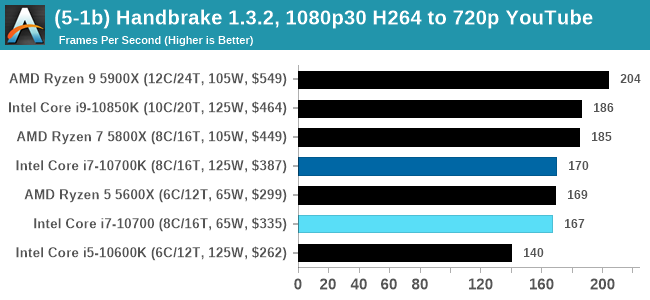
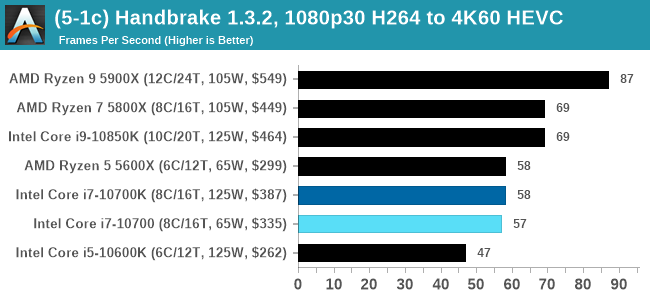
7-Zip 1900: Link
The first compression benchmark tool we use is the open-source 7-zip, which typically offers good scaling across multiple cores. 7-zip is the compression tool most cited by readers as one they would rather see benchmarks on, and the program includes a built-in benchmark tool for both compression and decompression.
The tool can either be run from inside the software or through the command line. We take the latter route as it is easier to automate, obtain results, and put through our process. The command line flags available offer an option for repeated runs, and the output provides the average automatically through the console. We direct this output into a text file and regex the required values for compression, decompression, and a combined score.

AES Encoding
Algorithms using AES coding have spread far and wide as a ubiquitous tool for encryption. Again, this is another CPU limited test, and modern CPUs have special AES pathways to accelerate their performance. We often see scaling in both frequency and cores with this benchmark. We use the latest version of TrueCrypt and run its benchmark mode over 1GB of in-DRAM data. Results shown are the GB/s average of encryption and decryption.
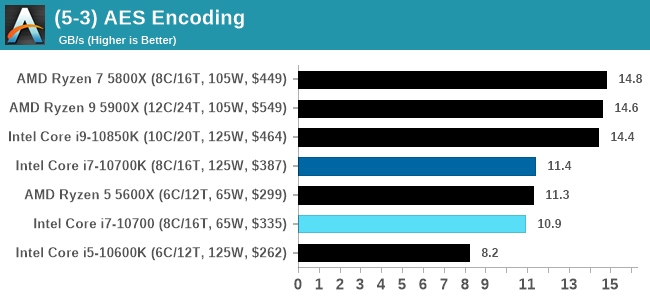
WinRAR 5.90: Link
For the 2020 test suite, we move to the latest version of WinRAR in our compression test. WinRAR in some quarters is more user friendly that 7-Zip, hence its inclusion. Rather than use a benchmark mode as we did with 7-Zip, here we take a set of files representative of a generic stack
- 33 video files , each 30 seconds, in 1.37 GB,
- 2834 smaller website files in 370 folders in 150 MB,
- 100 Beat Saber music tracks and input files, for 451 MB
This is a mixture of compressible and incompressible formats. The results shown are the time taken to encode the file. Due to DRAM caching, we run the test for 20 minutes times and take the average of the last five runs when the benchmark is in a steady state.
For automation, we use AHK’s internal timing tools from initiating the workload until the window closes signifying the end. This means the results are contained within AHK, with an average of the last 5 results being easy enough to calculate.
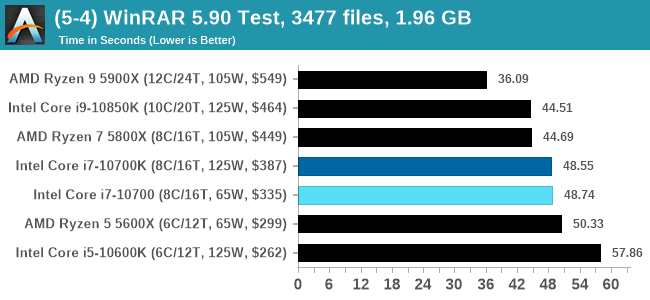


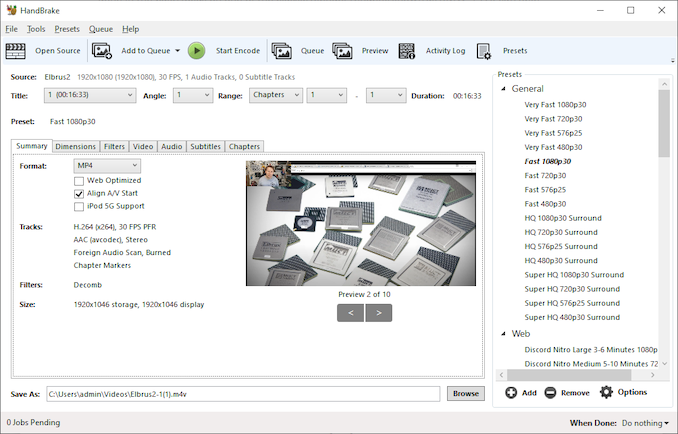
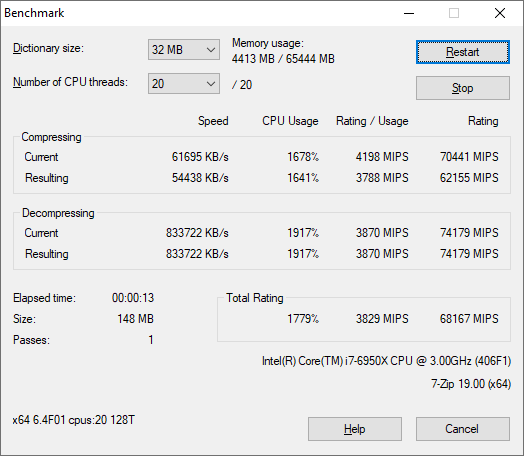
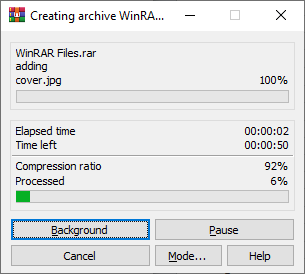








210 Comments
View All Comments
Marlin1975 - Thursday, January 21, 2021 - link
"65 watt" you keep using that word, I don't think it means what you think it means.YB1064 - Thursday, January 21, 2021 - link
From the first peak power chart, the 10700K consumes almost twice as much power as an equivalent AMD offering at that price point. The "65W" number is blatantly false advertising.heickelrrx - Friday, January 22, 2021 - link
10700k is not 65w part, 10700 is the one that labeled as 65wSamus - Friday, January 22, 2021 - link
Intel is just lying at this point as they are 'effectively' ~215w parts if you put them in a motherboard from Asus, Asrock, MSI, Gigabyte, etc. Only in an OEM system like an HP Elitedesk or Dell Workstation will they run anywhere close to their TDP rating but I'd guess they are using PL2 as well because why not, Intel said its ok.It's become painfully obvious Intel has had to resort to extreme measures here to compete. And compete is a pretty loose definition as they are using almost double the power of the competition and still slower clock for clock, dollar for dollar. No wonder Intel has shaken up the ranks, this is embarrassing.
Smell This - Friday, January 22, 2021 - link
The AMD 3rd Gen Ryzen Deep Dive Review:3700X (65w) and 3900X Raising The Bar
https://www.anandtech.com/show/14605/the-and-ryzen...
I snagged a Ryzen 3700X 8c/16t for $280 3 months ago. The price is at $325 or so these days until it is supplanted by a Ryzen 5700X. Makes the Core i7-10700 at 197w very, very sad.
Fully loaded (by Andrei & Gavin) was around 90w.
bananaforscale - Monday, January 25, 2021 - link
Doesn't matter, 10700 isn't really a 65W part either. I can deal with a 105W Ryzen pulling 150W under full load but having a "65W" part pull 215W is just BS. That's over triple and will overstress crap VRMs.III-V - Friday, January 22, 2021 - link
It's peak power... Not sustained power, which is what TDP deals with.shabby - Saturday, January 23, 2021 - link
It's 2.9ghz base clock uses 65w, that's what the tdp rating basically is.It would be nice if anandtech posted the actual wattage during each test for each cpu. Not just for many fps it got but how much wattage it used in that test.
Qasar - Saturday, January 23, 2021 - link
specially for games. keep reading how some say in games, intel is still better then amd when it comes to power usage, but dont really see much about it.scottlarm - Saturday, January 23, 2021 - link
gfh